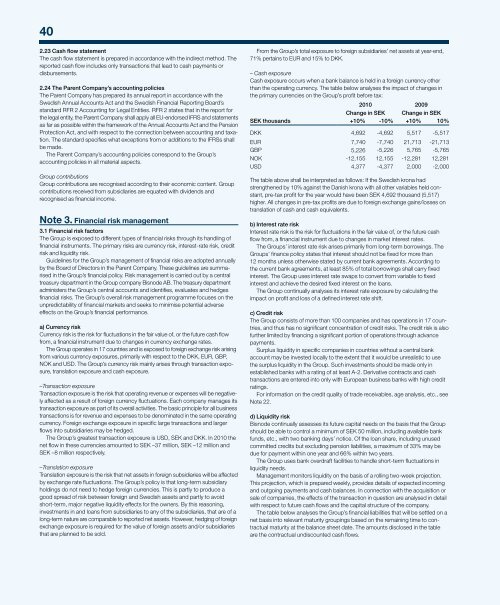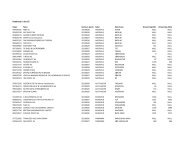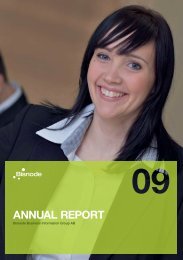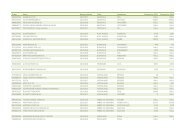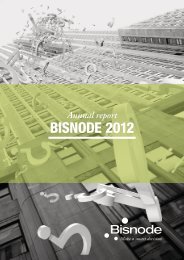Download PDF version - Bisnode
Download PDF version - Bisnode
Download PDF version - Bisnode
You also want an ePaper? Increase the reach of your titles
YUMPU automatically turns print PDFs into web optimized ePapers that Google loves.
40<br />
2.23 Cash flow statement<br />
The cash flow statement is prepared in accordance with the indirect method. The<br />
reported cash flow includes only transactions that lead to cash payments or<br />
disbursements.<br />
2.24 The Parent Company’s accounting policies<br />
The Parent Company has prepared its annual report in accordance with the<br />
Swedish Annual Accounts Act and the Swedish Financial Reporting Board’s<br />
standard RFR 2 Accounting for Legal Entities. RFR 2 states that in the report for<br />
the legal entity, the Parent Company shall apply all EU-endorsed IFRS and statements<br />
as far as possible within the framework of the Annual Accounts Act and the Pension<br />
Protection Act, and with respect to the connection between accounting and taxation.<br />
The standard specifies what exceptions from or additions to the IFRSs shall<br />
be made.<br />
The Parent Company’s accounting policies correspond to the Group’s<br />
accounting policies in all material aspects.<br />
Group contributions<br />
Group contributions are recognised according to their economic content. Group<br />
contributions received from subsidiaries are equated with dividends and<br />
recognised as financial income.<br />
note 3. financial risk management<br />
3.1 Financial risk factors<br />
The Group is exposed to different types of financial risks through its handling of<br />
financial instruments. The primary risks are currency risk, interest-rate risk, credit<br />
risk and liquidity risk.<br />
Guidelines for the Group’s management of financial risks are adopted annually<br />
by the Board of Directors in the Parent Company. These guidelines are summarised<br />
in the Group’s financial policy. Risk management is carried out by a central<br />
treasury department in the Group company <strong>Bisnode</strong> AB. The treasury department<br />
administers the Group’s central accounts and identifies, evaluates and hedges<br />
financial risks. The Group’s overall risk management programme focuses on the<br />
unpredictability of financial markets and seeks to minimise potential adverse<br />
effects on the Group’s financial performance.<br />
a) Currency risk<br />
Currency risk is the risk for fluctuations in the fair value of, or the future cash flow<br />
from, a financial instrument due to changes in currency exchange rates.<br />
The Group operates in 17 countries and is exposed to foreign exchange risk arising<br />
from various currency exposures, primarily with respect to the DKK, EUR, GBP,<br />
NOK and USD. The Group’s currency risk mainly arises through transaction exposure,<br />
translation exposure and cash exposure.<br />
–Transaction exposure<br />
Transaction exposure is the risk that operating revenue or expenses will be negatively<br />
affected as a result of foreign currency fluctuations. Each company manages its<br />
transaction exposure as part of its overall activities. The basic principle for all business<br />
transactions is for revenue and expenses to be denominated in the same operating<br />
currency. Foreign exchange exposure in specific large transactions and larger<br />
flows into subsidiaries may be hedged.<br />
The Group’s greatest transaction exposure is USD, SEK and DKK. In 2010 the<br />
net flow in these currencies amounted to SEK –37 million, SEK –12 million and<br />
SEK –8 million respectively.<br />
–Translation exposure<br />
Translation exposure is the risk that net assets in foreign subsidiaries will be affected<br />
by exchange rate fluctuations. The Group’s policy is that long-term subsidiary<br />
holdings do not need to hedge foreign currencies. This is partly to produce a<br />
good spread of risk between foreign and Swedish assets and partly to avoid<br />
short-term, major negative liquidity effects for the owners. By this reasoning,<br />
investments in and loans from subsidiaries to any of the subsidiaries, that are of a<br />
long-term nature are comparable to reported net assets. However, hedging of foreign<br />
exchange exposure is required for the value of foreign assets and/or subsidiaries<br />
that are planned to be sold.<br />
From the Group’s total exposure to foreign subsidiaries’ net assets at year-end,<br />
71% pertains to EUR and 15% to DKK.<br />
– Cash exposure<br />
Cash exposure occurs when a bank balance is held in a foreign currency other<br />
than the operating currency. The table below analyses the impact of changes in<br />
the primary currencies on the Group’s profit before tax:<br />
2010<br />
2009<br />
Change in SEK Change in SEK<br />
SEK thousands +10% -10% +10% 10%<br />
DKK 4,692 -4,692 5,517 -5,517<br />
EUR 7,740 -7,740 21,713 -21,713<br />
GBP 5,226 -5,226 5,765 -5,765<br />
NOK -12,155 12,155 -12,281 12,281<br />
USD 4,377 -4,377 2,000 -2,000<br />
The table above shall be interpreted as follows: If the Swedish krona had<br />
strengthened by 10% against the Danish krona with all other variables held constant,<br />
pre-tax profit for the year would have been SEK 4,692 thousand (5,517)<br />
higher. All changes in pre-tax profits are due to foreign exchange gains/losses on<br />
translation of cash and cash equivalents.<br />
b) Interest rate risk<br />
Interest rate risk is the risk for fluctuations in the fair value of, or the future cash<br />
flow from, a financial instrument due to changes in market interest rates.<br />
The Groups’ interest rate risk arises primarily from long-term borrowings. The<br />
Groups’ finance policy states that interest should not be fixed for more than<br />
12 months unless otherwise stated by current bank agreements. According to<br />
the current bank agreements, at least 85% of total borrowings shall carry fixed<br />
interest. The Group uses interest rate swaps to convert from variable to fixed<br />
interest and achieve the desired fixed interest on the loans.<br />
The Group continually analyses its interest rate exposure by calculating the<br />
impact on profit and loss of a defined interest rate shift.<br />
c) Credit risk<br />
The Group consists of more than 100 companies and has operations in 17 countries,<br />
and thus has no significant concentration of credit risks. The credit risk is also<br />
further limited by financing a significant portion of operations through advance<br />
payments.<br />
Surplus liquidity in specific companies in countries without a central bank<br />
account may be invested locally to the extent that it would be unrealistic to use<br />
the surplus liquidity in the Group. Such investments should be made only in<br />
established banks with a rating of at least A-2. Derivative contracts and cash<br />
transactions are entered into only with European business banks with high credit<br />
ratings.<br />
For information on the credit quality of trade receivables, age analysis, etc., see<br />
Note 22.<br />
d) Liquidity risk<br />
<strong>Bisnode</strong> continually assesses its future capital needs on the basis that the Group<br />
should be able to control a minimum of SEK 50 million, including available bank<br />
funds, etc., with two banking days’ notice. Of the loan share, including unused<br />
committed credits but excluding pension liabilities, a maximum of 33% may be<br />
due for payment within one year and 66% within two years.<br />
The Group uses bank overdraft facilities to handle short-term fluctuations in<br />
liquidity needs.<br />
Management monitors liquidity on the basis of a rolling two-week projection.<br />
This projection, which is prepared weekly, provides details of expected incoming<br />
and outgoing payments and cash balances. In connection with the acquisition or<br />
sale of companies, the effects of the transaction in question are analysed in detail<br />
with respect to future cash flows and the capital structure of the company.<br />
The table below analyses the Group’s financial liabilities that will be settled on a<br />
net basis into relevant maturity groupings based on the remaining time to contractual<br />
maturity at the balance sheet date. The amounts disclosed in the table<br />
are the contractual undiscounted cash flows.


